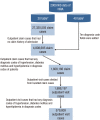Evidence of a broken healthcare delivery system in korea: unnecessary hospital outpatient utilization among patients with a single chronic disease without complications - PubMed (original) (raw)
Evidence of a broken healthcare delivery system in korea: unnecessary hospital outpatient utilization among patients with a single chronic disease without complications
Jin Yong Lee et al. J Korean Med Sci. 2014 Dec.
Abstract
This study aims to estimate the volume of unnecessarily utilized hospital outpatient services in Korea and quantify the total cost resulting from the inappropriate utilization. The analysis included a sample of 27,320,505 outpatient claims from the 2009 National Inpatient Sample database. Using the Charlson Comorbidity Index (CCI), patients were considered to have received 'unnecessary hospital outpatient utilization' if they had a CCI score of 0 and were concurrently admitted to hospital for treatment of a single chronic disease - hypertension (HTN), diabetes mellitus (DM), or hyperlipidemia (HL) - without complication. Overall, 85% of patients received unnecessary hospital services. Also hospitals were taking away 18.7% of HTN patients, 18.6% of DM and 31.6% of HL from clinics. Healthcare expenditures from unnecessary hospital outpatient utilization were estimated at: HTN (94,058 thousands USD, 38.6% of total expenditure); DM (17,795 thousands USD, 40.6%) and HL (62,876 thousands USD, 49.1%). If 100% of patients who received unnecessary hospital outpatient services were redirected to clinics, the estimated savings would be 104,226 thousands USD. This research proves that approximately 85% of hospital outpatient utilizations are unnecessary and that a significant amount of money is wasted on unnecessary healthcare services; thus burdening the National Health Insurance Service (NHIS) and patients.
Keywords: Costs and Cost Analysis; Primary Health Care; Referral and Consultation; Utilization.
Conflict of interest statement
The authors have no conflicts of interest to disclose.
Figures
Fig. 1
The data management process using HIRA-NIS database. *Data of general information about claim cases; †Data of diagnosis information about claim cases. NIS, National Inpatient Sample; HIRA, Health Insurance Review & Assessment Service.
Similar articles
- Healthcare utilization and costs of patients with rosacea in an insured population.
Romanowicz M, Stephenson JJ, Del Rosso JQ, Lenhart G. Romanowicz M, et al. J Drugs Dermatol. 2008 Jan;7(1):41-9. J Drugs Dermatol. 2008. PMID: 18246697 - Somatization increases medical utilization and costs independent of psychiatric and medical comorbidity.
Barsky AJ, Orav EJ, Bates DW. Barsky AJ, et al. Arch Gen Psychiatry. 2005 Aug;62(8):903-10. doi: 10.1001/archpsyc.62.8.903. Arch Gen Psychiatry. 2005. PMID: 16061768 - Utilization and costs for children who have special health care needs and are enrolled in a hospital-based comprehensive primary care clinic.
Berman S, Rannie M, Moore L, Elias E, Dryer LJ, Jones MD Jr. Berman S, et al. Pediatrics. 2005 Jun;115(6):e637-42. doi: 10.1542/peds.2004-2084. Pediatrics. 2005. PMID: 15930189 - [Effects of multimorbidity on health care utilization and costs].
Lehnert T, König HH. Lehnert T, et al. Bundesgesundheitsblatt Gesundheitsforschung Gesundheitsschutz. 2012 May;55(5):685-92. doi: 10.1007/s00103-012-1475-6. Bundesgesundheitsblatt Gesundheitsforschung Gesundheitsschutz. 2012. PMID: 22526857 Review. German. - Multiple chronic conditions and healthcare costs among adults.
Sambamoorthi U, Tan X, Deb A. Sambamoorthi U, et al. Expert Rev Pharmacoecon Outcomes Res. 2015;15(5):823-32. doi: 10.1586/14737167.2015.1091730. Expert Rev Pharmacoecon Outcomes Res. 2015. PMID: 26400220 Free PMC article. Review.
Cited by
- A nationwide study of regional preference and graft survival of kidney transplantation in South Korea: patterns of centralization in the capital area.
Park JI, Jang Y, Park H, Pyun S, Cho HR, Park SJ. Park JI, et al. Ann Surg Treat Res. 2024 Jan;106(1):11-18. doi: 10.4174/astr.2024.106.1.11. Epub 2023 Dec 28. Ann Surg Treat Res. 2024. PMID: 38205095 Free PMC article. - Unmet Needs and Barriers in Providing Hospital Care for Older Adults: A Qualitative Study Using the Age-Friendly Health System Framework.
Yi Y, Lee Y, Kang S, Kwon YH, Seo YM, Baek JY, Jang IY, Lee E, Koh Y, Jung HW, Park CM. Yi Y, et al. Clin Interv Aging. 2023 Aug 11;18:1321-1332. doi: 10.2147/CIA.S409348. eCollection 2023. Clin Interv Aging. 2023. PMID: 37588681 Free PMC article. - Cancer care patterns in South Korea: Types of hospital where patients receive care and outcomes using national health insurance claims data.
Choi DW, Kim SJ, Kim S, Kim DW, Jeong W, Han KT. Choi DW, et al. Cancer Med. 2023 Jul;12(13):14707-14717. doi: 10.1002/cam4.6093. Epub 2023 May 18. Cancer Med. 2023. PMID: 37199387 Free PMC article. - The ecology of medical care in Korea: the association of a regular doctor and medical care utilization.
Lee J, Choi YJ, Ryu DH. Lee J, et al. BMC Health Serv Res. 2022 Nov 28;22(1):1423. doi: 10.1186/s12913-022-08821-6. BMC Health Serv Res. 2022. PMID: 36443702 Free PMC article. - National Trends in Hospitalization for Ambulatory Care Sensitive Conditions among Korean Adults between 2008 and 2019.
Park H, Son MJ, Jung DW, Lee H, Lee JY. Park H, et al. Yonsei Med J. 2022 Oct;63(10):948-955. doi: 10.3349/ymj.2022.0110. Yonsei Med J. 2022. PMID: 36168248 Free PMC article.
References
- Song YJ. The South Korean health care system. Japan Med Assoc J. 2009;52:206–209.
- Kwon S. Payment system reform for health care providers in Korea. Health Policy Plan. 2003;18:84–92. - PubMed
- Chun CB, Kim SY, Lee JY, Lee SY. Republic of Korea: health system review. Health Syst Transit. 2009;11:1–184.
- Kwon S. Thirty years of national health insurance in South Korea: lessons for achieving universal health care coverage. Health Policy Plan. 2009;24:63–71. - PubMed
MeSH terms
LinkOut - more resources
Full Text Sources
Other Literature Sources
Medical
